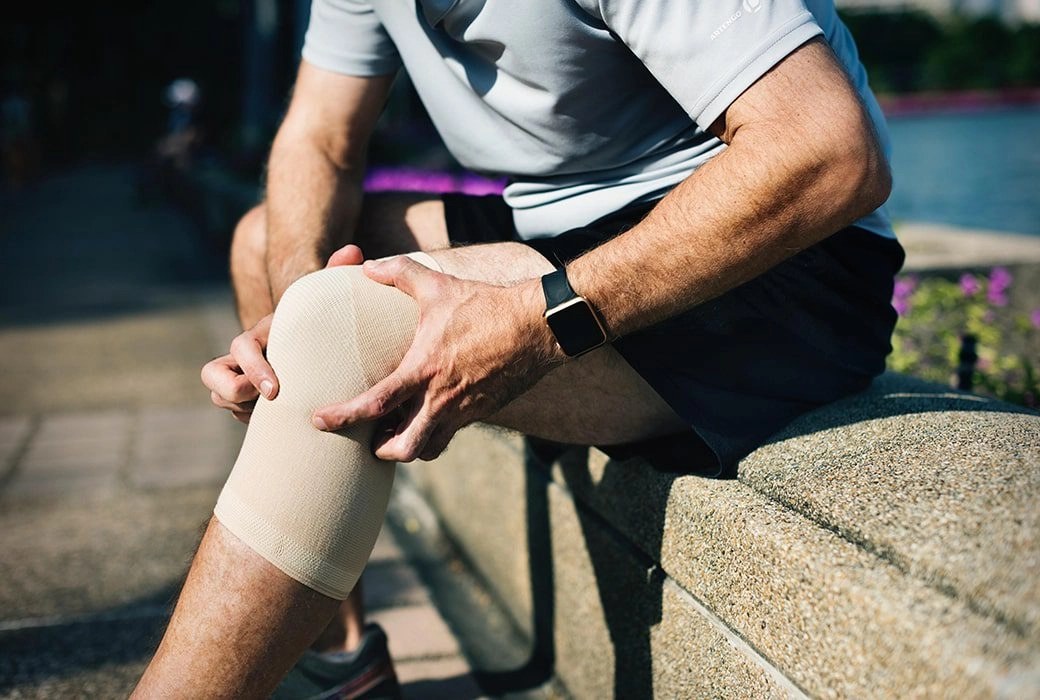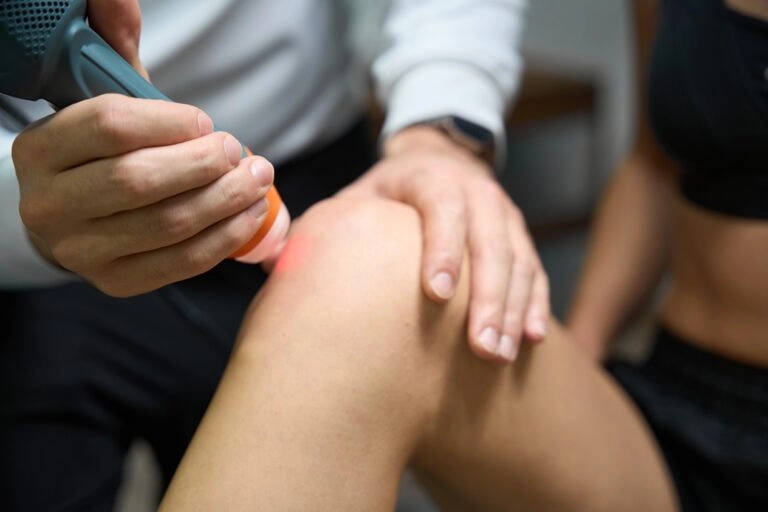Bursitis of the knee is a painful condition that causes aches in the area and can make it difficult to move around and perform your everyday tasks. Knee bursitis can also limit your range of motion, and prevent you from doing certain exercises you may have in your routine.
The good news is that knee bursitis is usually a curable condition that can be alleviated with some simple solutions, or a quick visit to a Chiropractor. Below we’ll go over some general information about the condition so that you’re well-aware of what you’re dealing with. Then, we’ll get into some traditional treatments for the condition, as well as some home remedies you can employ to get yourself back on your feet, so to speak, as quickly as possible! Let’s dive in.
What is Knee Bursitis?
Basically, knee bursitis is an inflammation of a bursa located on the knee or knees. But, you may be wondering, what exactly is a bursa? A bursa is a closed sac filled with bodily fluids that has a smooth surface. They are located in all major joints in the body, including shoulders, hips, elbows, and knees. Their function is to reduce friction in between the soft and hard tissues and bones in these joints, to help them run and function smoothly, as they should.
However, it is relatively easy for a bursa to become inflamed, causing fairly intense pain and limited motion. While the aches and pains associated with bursitis aren’t necessarily as bad as those of another joint condition, such as arthritis, it is still a condition that hinders your lifestyle and causes pain. Therefore, it is something that should be dealt with as soon as possible.
Knee bursitis, in particular, is very painful in comparison to other types of bursitis, because on top of the inflammation, your knees are also carrying the weight of most of your body. This just exacerbates the condition and makes the pain worse.
Types of Bursitis That Affect the Knees
There are three bursae (plural for bursa) in the knees; the prepatellar bursa, the pes anserine bursa, and the infrapatellar bursa. The most common place where one can find knee bursitis is in the prepatellar bursa, which is located right over the kneecap. Bursitis is also common in the pes anserine bursa, which is located inside the knees. Although infrapatellar bursitis is not common, that area should still be checked regularly if you experience knee pain.
Prepatellar bursitis is so common because that bursa becomes inflamed from kneeling for long periods of time, which is required in positions like carpentry, roofing, plumbing, childcare, cleaning, and other common careers. This kind of bursitis is also colloquially referred to as “roofer’s knee” or housemaid’s knee” for that reason.
Causes of Knee Bursitis
While kneeling for long periods of time can cause knee bursitis, there are other risk factors involved as well. Another common cause is injury, or some other type of trauma, to the knee. Driving accidents commonly cause bursitis due to the position of the knees at the time of impact.
This means people of any age are susceptible to the condition, although it is more common in older adults (aged 40+) than children, possibly just due to general inability to recover as quickly. As we age, our muscles and bones also get weaker over time, which makes us more likely to get a condition like this.
Other potential causes and risk factors for knee bursitis include tight hamstring muscles and a neglect to stretch during exercise, sudden increase in use/movement, osteoarthritis in the knee, or bodily imbalances, including a broad pelvis, different leg lengths, or pronation of the feet.
Symptoms of Knee Bursitis
Most patients that have knee bursitis report the same symptoms, which include:
- Radiating warmth from inflammation of the area
- Swelling of the knee
- Stiffness of the affected area
- Tender to the touch
- Pain and aches
Often, the pain is not nearly as severe as a degenerative joint condition like arthritis, but it is still an issue, and can be much more painful for people who have to use that area everyday in their line of work. That situation can also make the condition much worse if not treated immediately and properly.
Most Effective Treatments for Knee Bursitis
That is why effective treatments for knee bursitis are so incredibly important to people who suffer from the condition. If you or a loved one has had it before, you know just how important early intervention is so that you can get back to your life as quickly as possible. However, depending on the type of bursitis and the severity, there are a few avenues you can take in terms of bursitis of the knee treatment.
Traditional/Common Treatment Methods
Traditional treatment for knee bursitis is fairly straightforward and intuitive. Most doctors will prescribe lots of rest, ice packs at home, and anti-inflammatory over the counter pain medications (or more intense ones, only if absolutely necessary). They may also suggest compression and a few days off from work and regular activity in order to get it functioning back to normal.
Depending on the severity of the inflammation of the bursa, it may need to be drained as well in addition to these other treatments. Often, this can be done right on site in the doctor’s office with a simple syringe injection/extraction.
If the bursitis is septic, meaning it has become infected, antibiotics may be prescribed by your doctor to take down the infection and heal the bursa. This might also require a draining of the bursa a few times over, if it becomes inflamed again by the infection.

Light Therapy Treatment Method
A less traditional, but still incredibly effective, treatment method for bursitis of the knee is light therapy treatment. This involves an infrared light being projected onto the area, penetrating the skin layers and healing the inflamed bursa without any invasive methods or oral medications. Unfortunately, this treatment method comes with a hefty price tag, but it is very effective at reducing inflammation and alleviating pain from knee bursitis.
Supportive Braces
Last, but certainly not least, one of the most effective at-home treatment methods for bursitis is using a knee brace in your day-to-day activities. While it would be best if you could take a few days to rest and get back into remission, you can still walk about and do some basic tasks with the help of a knee brace. These should also be worn in the weeks after your bursitis has healed in order to help it fully adjust and give it extra support in this tender time.
Knee braces are extremely valuable tools for this condition because the compression helps to reduce the swelling that comes with the condition, and also helps support the body and takes some of the weight and pressure off of the knee itself, allowing it to heal and not get re-injured. It adds stability, decreases pain, and reduces inflammation associated with bursitis, so this is the first thing you should turn to if you suspect you have knee bursitis and can’t see a doctor right away.
Final Thoughts on Knee Bursitis
Bursitis is a condition that can affect bursas in any part of the body, particularly in the large joints like the shoulders, hips, and knees. It involves an inflammation of the bursa, or the sac of fluid, that keeps the joints functioning properly. In addition to the pain caused by the inflammation, it can also cause pain in the overall joint itself since it loses its proper function and strength with this condition.
Knee bursitis can be particularly painful because in addition to this pain, the knees also take on the weight and pressure of the entire body, thus making the pain worse and potentially prolonging healing time if not addressed properly.
Luckily, there are plenty of treatment methods out there that effectively and quickly reduce symptoms and heal this condition in no time. Normally, a few restful days, along with ice, compression, and some over the counter anti-inflammatory medications will do the trick. However, if the condition is more severe, it may warrant a doctor draining the fluid in the bursa in order to help it heal more quickly. Rare cases involve surgery, but for most people, it is just a few days before they’re back on their feet.
Make sure to consult a physician as soon as possible if you suspect you have bursitis, mostly to ensure that it is not a worse condition, and for them to give you the best treatment possible, tailored to your situation and needs. If you do, you’ll be back to your daily, pain-free lifestyle sooner than you think!









